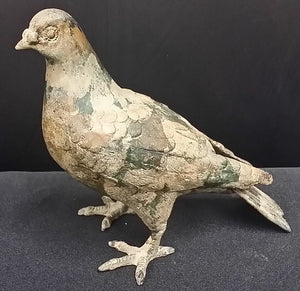
Bronze Bird Sculpture, Gilt, Chinese, 19th Century.
Bronze Bird Sculpture, Gilt, Chinese, 19th Century.
The long period of the Bronze Age in China, which began around 2000 B.C., saw the growth and maturity of a civilization that would be sustained in its essential aspects for another 2,000 years. In the early stages of this development, the process of urbanization went hand in hand with the establishment of social order. In China, as in other societies, the mechanism that generated social cohesion, and at later stage statecraft, was ritualization. As most of the paraphernalia for early rituals were made in bronze and as rituals carried such an important social function, it is perhaps possible to read into the forms and decorations of these objects some of the central concerns of the societies (at least the upper sectors of the societies) that produced them.
There were probably a number of early centres of bronze technology, but the area along the Yellow River in present-day Henan Province emerged as the centre of the most advanced and literate cultures of the time and became the seat of the political and military power of the Shang dynasty (ca. 1600–1050 B.C.), the earliest archaeologically recorded dynasty in Chinese history. The Shang dynasty was conquered by the people of Zhou, who came from farther up the Yellow River in the area of Xi’an in Shaanxi Province. In the first years of the Zhou dynasty (ca. 1046–256 B.C.), known as the Western Zhou (ca. 1046–771 B.C.), the ruling house of Zhou exercised a certain degree of “imperial” power over most of central China. With the move of the capital to Luoyang in 771 B.C., however, the power of the Zhou rulers declined and the country divided into a number of nearly autonomous feudal states with nominal allegiance to the emperor. The second phase of the Zhou dynasty, known as the Eastern Zhou (771–256 B.C.), is subdivided into two periods, the Spring and Autumn period (770–ca. 475 B.C.) and the Warring States period (ca. 475–221 B.C.). During the Warring States period, seven major states contended for supreme control of the country, ending with the unification of China under the in 221 B.C.
Although there is uncertainty as to when metallurgy began in China, there is a reason to believe that early bronzeworking developed autonomously, independent of outside influences. The era of the Shang and the Zhou dynasties is generally known as the Bronze Age of China, because bronze, an alloy of copper and tin, used to fashion weapons, parts of chariots, and ritual vessels played an important role in the material culture of the time. Iron appeared in China toward the end of the period, during the Eastern Zhou dynasty.
The earliest Chinese bronzes were made by the method known as a piece-mould casting, as opposed to the lost-wax method, which was used in all other Bronze Age cultures. In piece-mould casting, a model is made of the object to be cast, and a clay mould taken of the model. The mould is then cut in sections to release the model, and the sections are reassembled after firing to form the mould for casting. If the object to be cast is a vessel, a core has to be placed inside the mould to provide the vessel’s cavity. The piece-mould method was most likely the only one used in China until at least the end of the Shang dynasty. An advantage of this rather cumbersome way of casting bronze was that the decorative patterns could be carved or stamped directly on the inner surface of the mould before it was fired. This technique enabled the bronzeworker to achieve a high degree of sharpness and definition in even the most intricate designs.
Item Code - BRO2C281OAC
Width: 7 1/2" Height: 6 1/2" Depth: 4 1/2" Weight: 1.041 kg





